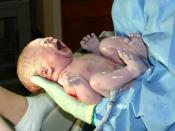Babies are born with the ability to cry, which is how they do most of their communicating. A baby's cries generally tell you that something is wrong in their world. In fact, sometimes what a baby needs can be identifies by her cry- for example the "I'm hungry" cry may be short and low pitched, while "I'm upset" may sound jerky.
A baby's smile says "I'm happy" or "Do that game again!" A baby cries to let us know "I'm hungry" or "I need a nappy change. From the first month on, babies listen and pay attention to important voices around them. They discover their voices and play with sounds in squeals, grunts and gurgles.
But a baby's language can be more subtle. For example if a baby turns her face away during a game it means "I don't want to play anymore". Some tired babies will rub their eyes, or cuddle up into a adult's shoulder if they want to go to sleep.
Babies also cry when they are overwhelmed by all off the sights and sounds of the world. Sometimes they may even cry for no apparent reason.
A newborn can differentiate between the sound of a human voice and other sounds. Babies already associate their parent's voice with care, food, warmth and touch. They will respond to the sound of their parent's voice by becoming quiet, smiling or getting excited and moving their arms and legs. They will begin smiling regularly at their parents during this period. Babies this age discover that they have the ability to vocalize. Some babies begin to make vowel sounds, like "ah-ah" or "ooh-ooh" at about 2 months. Babies will talk to their parents with a variety of sounds; they'll smile and wait for their parents response. A baby's legs will...



I like it!
This essay really let me know some things about babies that I really didn't know. Very Interesting! You should have got a 100% on this essay, not a 85%.
4 out of 4 people found this comment useful.